If you’re interested in creating a project like this, let us know!

Across California, from the halls of the Sacramento capitol to city council meetings to community group discussions, the subject of housing cost is front and center. And nowhere is this issue felt more acutely than the San Francisco Bay area, a region that has added 11 jobs for every one home since 2010. This extreme mismatch in jobs and housing growth has seen the median home price in the Bay Area rise to $934,000, with San Francisco at $1.4 million and Silicon Valley enclave Palo Alto at a staggering $3.1 million. Rents in San Francisco have risen more than 60% since 2012.
State policy makers are focusing on housing like never before, and no pending bill has garnered more attention than Scott Weiner’s SB 827, which, until it was blocked by the Senate Transportation and Housing Committee on April 17, looked to substantially increase housing production around all major transit stops and lines in the state. Our previous analysis of the bill, which looked at three BART stations in the East Bay of the San Francisco Bay Area, drew attention, including coverage in the New York Times. In response to this coverage, and in particular because SB 827 just suffered an early defeat, we wanted to wade deeper into the housing issue. This time, we used UrbanFootprint to explore how and where we can address California’s housing supply crisis, and explore how different approaches to housing production might impact other parts of the Bay Area and California.
We set our sights within the heart of Silicon Valley, at one of its most critical arteries, El Camino Real, which extends nearly 45 miles from Daly City in the north to San Jose in the south. It snakes through 15 cities and two counties – past countless office parks, commercial strip centers and malls, and residential zones. There have been numerous efforts to enhance the corridor. Particular attention has been given to adding more housing to address critical needs – the most prominent being the Grand Boulevard Initiative. But thus far we have not seen a comprehensive study of what might be possible and feasible, especially in the context of bills like SB 827. We wanted to narrow the information gap and insert some data-driven insight into the mix.
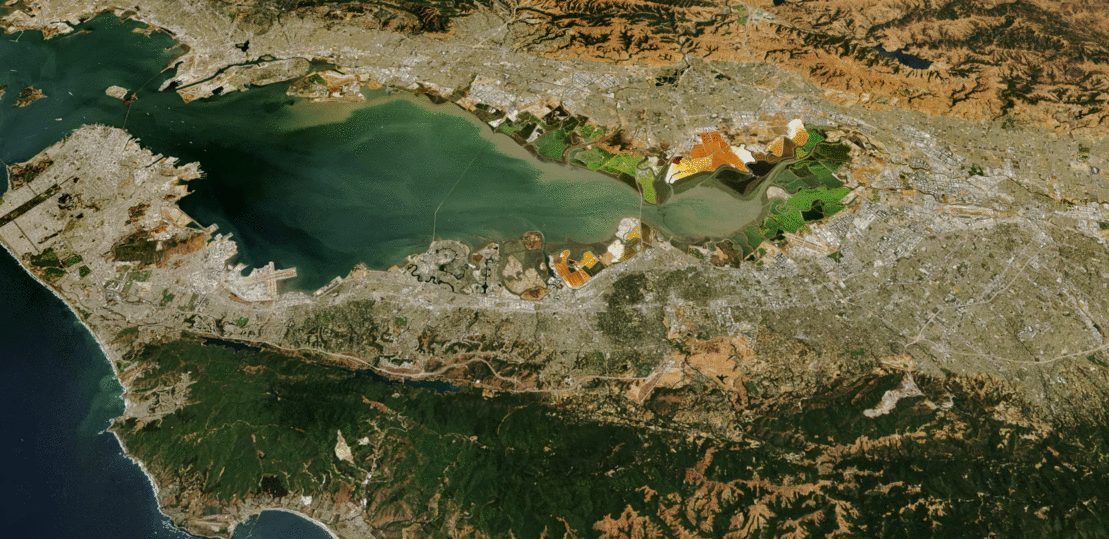
El Camino Today
While El Camino changes in character as it winds up and down the peninsula, it is mostly suburban in nature throughout its length. The area within a half mile of the corridor is lined by more than 2,000 acres of relatively low intensity commercial development and nearly 100,000 office jobs.

It is home to more than 55,000 single family residences and another 90,000 apartments and townhomes. BART rail extends from San Francisco to the north end of the corridor, and Caltrain commuter rail service runs along, or close to, most of the corridor. Valley Transportation Authority (VTA) light rail service touches the corridor in Mountain View, connecting to San Jose and other Santa Clara County job centers. Future High Speed Rail and other major transit service upgrades are slated to show up in the following years and decades.

| Corridor Summary Statistics | ¼ mile buffer | ½ mile buffer |
|---|---|---|
| Number of Parcels | 39,599 | 79,297 |
| Parcel Area (acres) | 13,105 | 23,488 |
| Low-Intensity Commercial Parcel Count | 2,814 | 3,639 |
| Low-Intensity Commercial Parcel Area (acres) | 1,607 | 2,036 |
| Low-Intensity Residential Parcel Count | 33,220 | 69,705 |
| Low-Intensity Residential Parcel Area (acres) | 5,645 | 11,863 |
| Population (Existing Conditions) | 209,900 | 384,000 |
| Housing Units (Existing Conditions) | 80,100 | 146,000 |
| Employees (Existing Conditions) | 154,400 | 232,000 |
How much housing can the El Camino corridor accommodate?
With all of this transportation infrastructure, low intensity commercial development, and the country’s highest home prices as the backdrop, we set out to explore how more housing could be accommodated on the El Camino corridor. What if single-use commercial strip development was replaced with mixed-use buildings and housing? How much housing could fit on the corridor in four story buildings? Five story buildings? What if we focused more intense development around rail stations? We built a range of scenarios to test such options. We also looked at how housing capacity would be impacted by SB 827, which, until it was blocked in the Senate, looked to focus new housing development on existing residential parcels within a half mile of major transit stations and infrastructure.
After analyzing existing conditions, we created and examined a few scenarios for accommodating more housing. We leveraged UrbanFootprint’s parcel data and transit layers to select parcels based on specific characteristics and to find development opportunities within walking distance of major rail transit services like BART and Caltrain. For this study, we stayed away from redeveloping or upzoning major office developments on the corridor, instead focusing on how much more housing could be accommodated in existing commercial and residential uses.
Four Proposed Scenarios
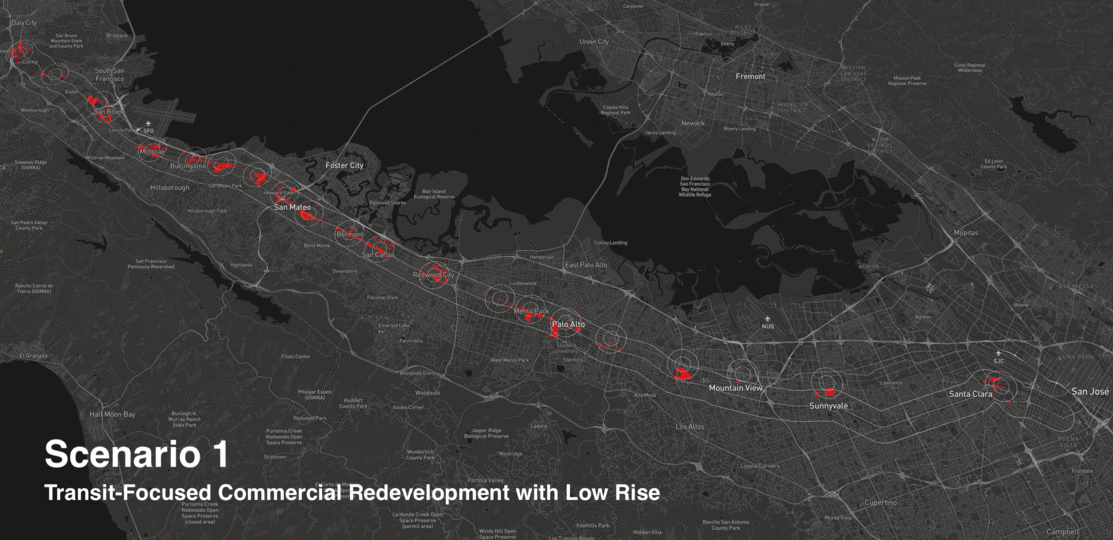
We settled on the following range of scenarios, with one taking on SB 827’s residential upzone focus and three others concentrating new housing and mixed-use development on commercial parcels:
#1 Transit-Focused Commercial Redevelopment with Low Rise: All low-intensity commercial parcels that are both within a half mile of a rail stop and within a half mile of El Camino Real converted to low-rise (about three to five story) mixed use (residential and retail) development.
#2 Transit-Focused Commercial Redevelopment with Low and Mid Rise: All low-intensity commercial parcels that are both within a quarter mile of a Caltrain stop and within a half mile of El Camino Real converted to mid-rise (about seven to eight story) mixed use development. Those within a half mile of a rail stop and within a half mile of El Camino Real converted to low-rise mixed use development.
#3 Corridor-Wide Commercial Redevelopment: All low-intensity commercial parcels within a half mile of El Camino Real are converted to low-rise mixed use development.
#4 SB 827 Residential Upzone: This scenario presents the theoretical maximum housing production that would have been possible under SB 827 as it was drafted in its last (April 9, 2018) amendment. Residential parcels within a quarter mile of High Quality Transit Areas (HQTAs defined as current transit stops with better than 15 minute headways during peak hours) are upzoned to about five stories (limited to development directly lining El Camino Real), while those within a half mile are upzoned to four-story residential and mixed-use development. We used HQTAs as designated by the Transit Rich Housing analysis.
| Parcels Impacted | Acres Impacted | Total Housing Units | Additional Housing Units | |
|---|---|---|---|---|
| Existing Conditions | – | – | 146,000 | – |
| 1: Transit-Focused Commercial Redevelopment with Low Rise | 2,050 | 1,000 | 266,000 | 120,000 |
| 2: Transit-Focused Commercial Redevelopment with Low and Mid Rise | 2,050 | 1,000 | 302,500 | 156,500 |
| 3: Corridor-Wide Commercial Redevelopment | 3,750 | 2,100 | 395,900 | 249,900 |
| 4: SB 827 Residential Upzone | 16,950 | 2,850 | 453,000 | 307,000 |
As the summary chart shows, the scenarios vary in the number of parcels and land area they impact, ranging from 2,050 commercial parcels in the most transit-focused redevelopment, to 3,750 for the commercial redevelopment option that includes the El Camino corridor strip, to the more than 16,950 residential parcels impacted in the SB 827 scenario.
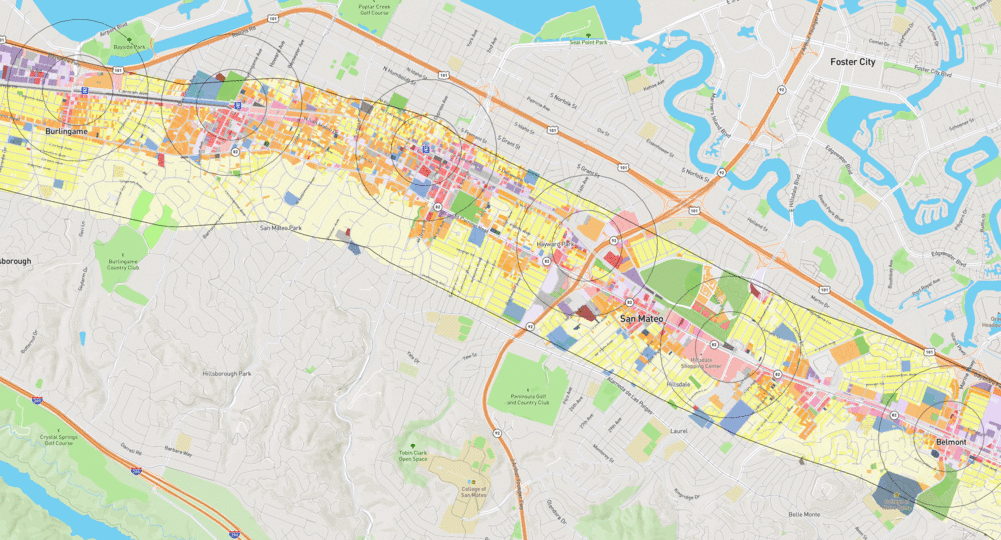
All of the scenarios net significant gains in housing. It is important to emphasize that all scenarios represent theoretical maximums and would only be realized if every parcel in each scenario were to be redeveloped. That said, even if just a portion of parcels redevelop over time, the impact on housing supply and, in turn, affordability would be substantial. The varying approaches in each of the scenarios underscore that there are a number of different approaches to accommodating increased housing along the length of El Camino.
Total Housing by Type
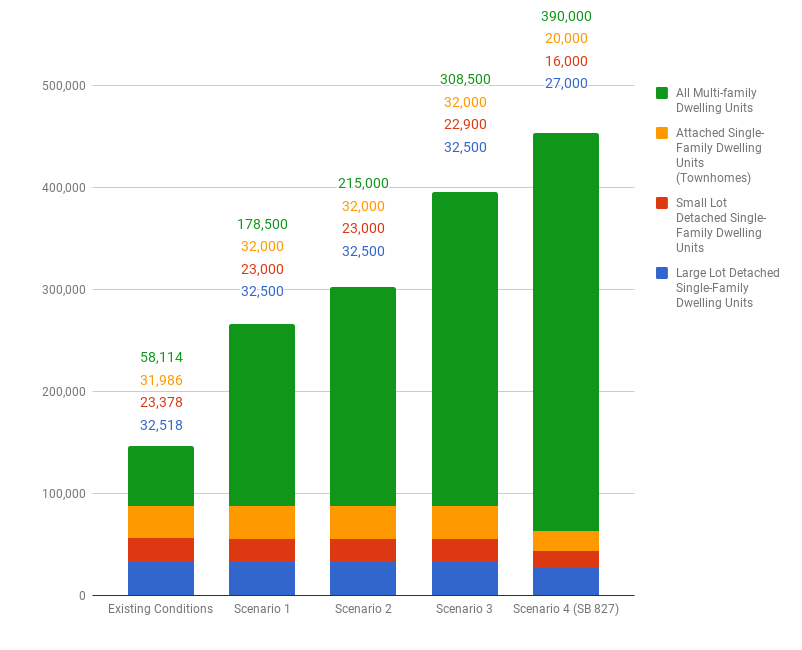
Cities can focus on lower-intensity commercial parcels and leave residential parcels off the table; take on residential upzoning as suggested by SB 827; or combine various approaches where appropriate. Some cities are already taking on some of these tactics, through programs like the the Grand Boulevard Initiative, city General Plan updates, and new developments. Our study looks at the impact of such activities across the entire length of the corridor, highlighting the importance of El Camino and suburban corridors like it in addressing housing and other challenges in the Bay Area, California, and the across the United States.
How did we build the El Camino scenarios?
Playing out scenarios like we did in this study serves to bracket possibilities and adds context and depth, which is all-too-often missing from community conversations and policy development. A study like this typically takes weeks or months, with most of the time spent collecting, cleaning, and preparing land use and transportation data across multiple jurisdictions. With UrbanFootprint, we were able to get the study going in just a few minutes.
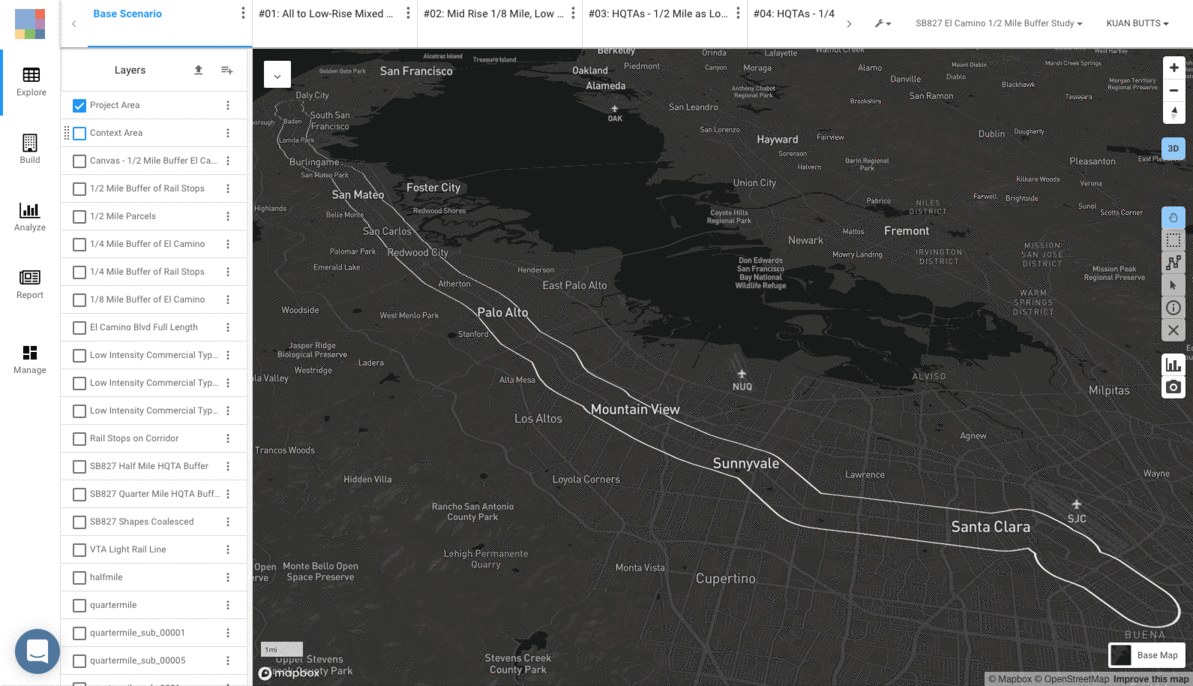
First, we created a project by designating the work area. UrbanFootprint loads the corresponding, built-in parcel data and a host of other layers for all jurisdictions along the El Camino corridor.
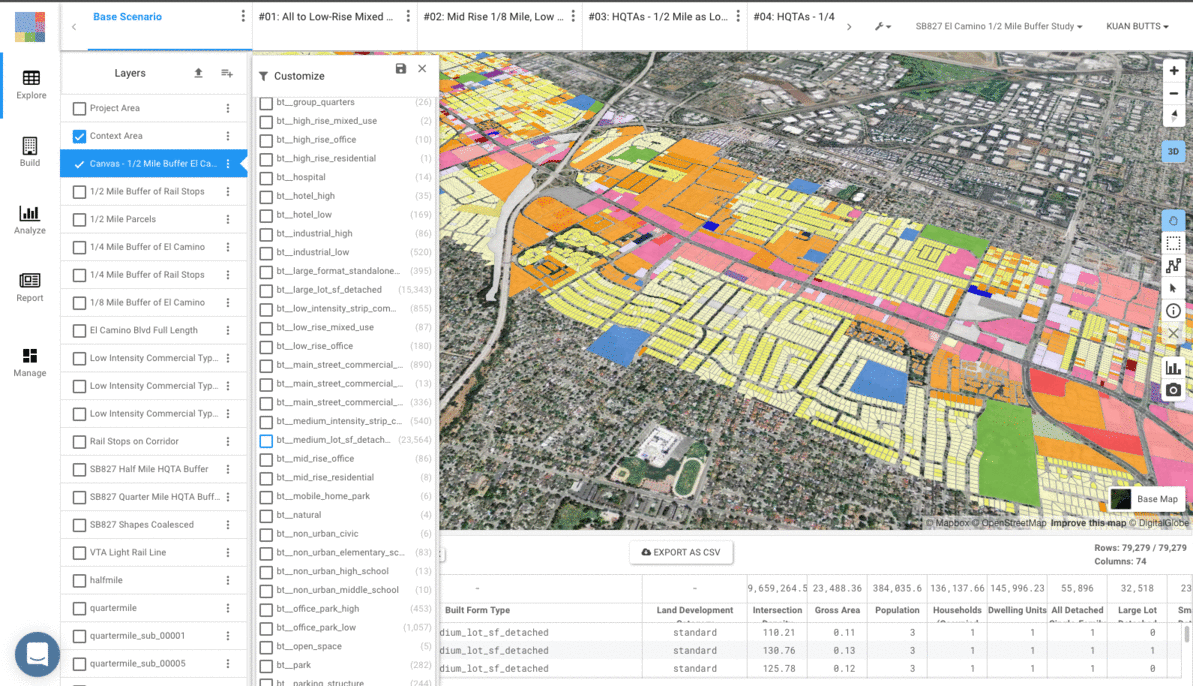
Next, we used filters to understand what’s on the ground today, select parcels by type and location, and update them to another land use. We used UrbanFootprint’s many built-in building types and created a few of our own custom types for this study.
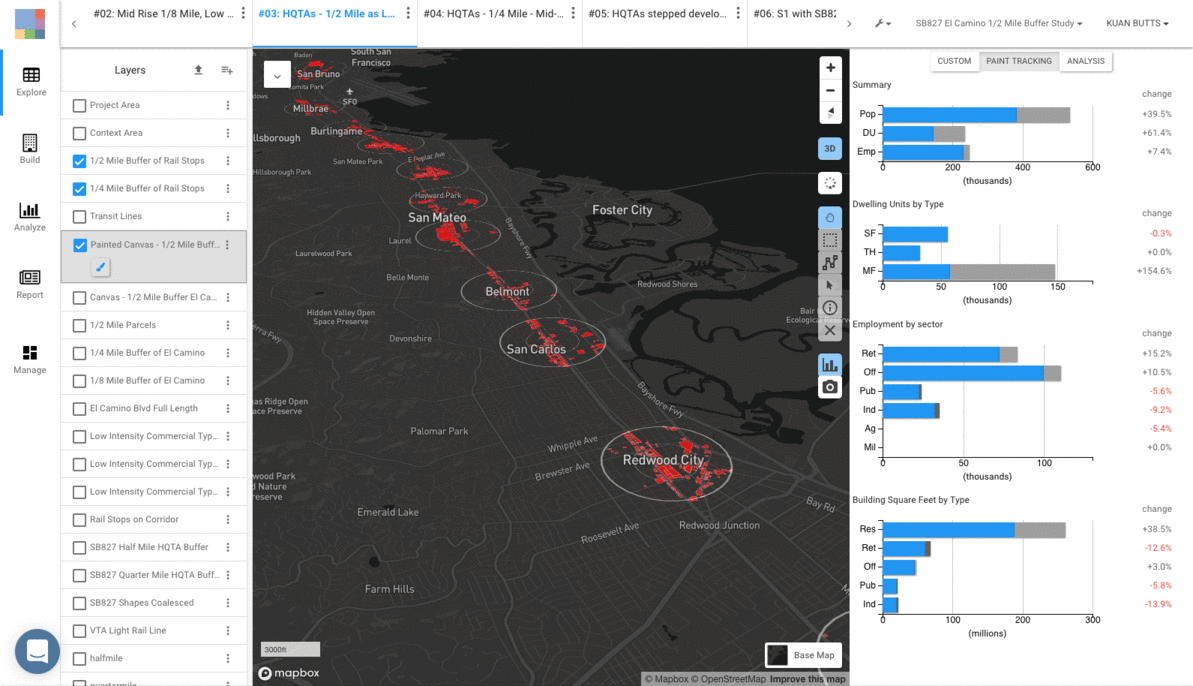
We created new scenarios to explore a range of options over the course of just a few hours.
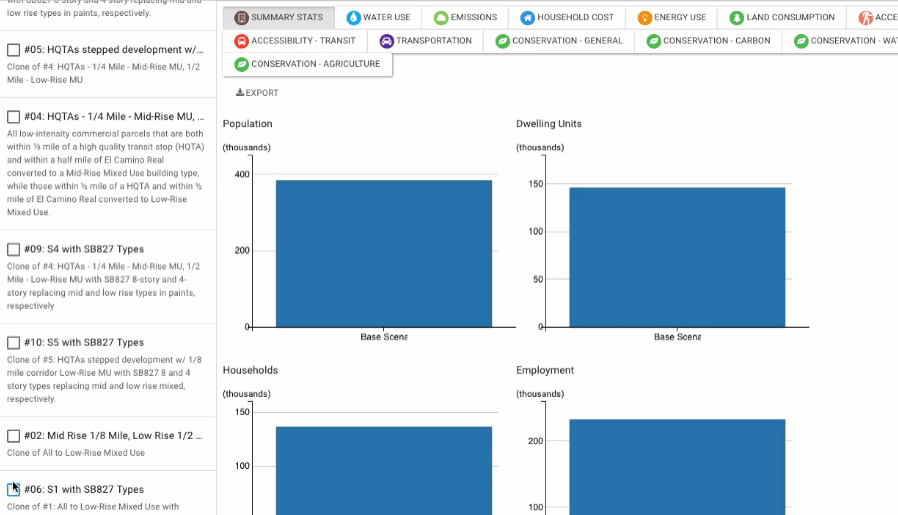
UrbanFootprint’s dynamic reporting capabilities allowed us to track progress as we worked, comparing scenarios for their impact on energy use, water use, transit accessibility, emissions and other key indicators.
Learn More
Have a question about this study or interested in exploring another initiative in your area? We’re looking to perform similar studies for more places in California and across the country. Tweet or email to let us know what you’d like to see next, or go ahead and dive into the data yourself: Check out a free trial of UrbanFootprint or sign up for a custom demo with our team to learn more.
In the meantime, be on the lookout for more posts from current UrbanFootprint users leveraging the platform to build and analyze projects across the U.S. to provide data-driven insights on initiatives ranging from city-wide plans, to corridor and neighborhood studies, to master plans and site analysis. We’ll also be including more comprehensive reporting on the impacts of the El Camino scenarios, including how the scenarios impact energy, water, transportation, emissions, and household cost burdens. Stay tuned!








